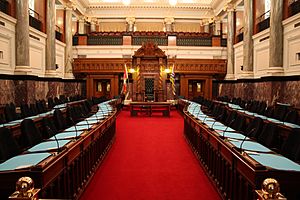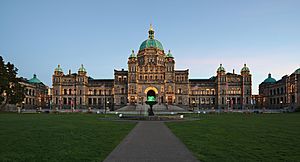British Columbia Parliament Buildings facts for kids
Quick facts for kids British Columbia Parliament Buildings |
|
|---|---|
 |
|
| General information | |
| Architectural style | Neo-baroque Renaissance Revival Romanesque Revival |
| Address | 501 Belleville Street |
| Town or city | Victoria, British Columbia |
| Country | Canada |
| Construction started | 1893 |
| Completed | 1897 |
| Design and construction | |
| Architect | Francis Rattenbury |
The British Columbia Parliament Buildings are a very important place in Victoria, British Columbia, Canada. They are where the Legislative Assembly of British Columbia meets. This is like the provincial government, where elected members make laws for British Columbia.
People like the Speaker and the Serjeant-at-Arms help manage these buildings and the surrounding area. The buildings face the Inner Harbour and are across from The Empress Hotel.
On the front lawn, you can see a statue of Queen Victoria. There is also a special monument called the British Columbia Legislature Cenotaph. It remembers people from the province who died in World War I, World War II, the Korean War, and the Afghanistan War. High up on the main dome, there's a gold statue of Captain George Vancouver. You can take free guided tours of the buildings all year round!
Contents
A Look Back: History of the Parliament Buildings
The story of British Columbia's Parliament Buildings is quite interesting. Before these grand buildings, the government met in different places.
The "Birdcages"
From 1860 to 1898, the legislature met in a group of wooden buildings. People called them "The Birdcages" because of their unusual shape. These buildings were not very good. They were often drafty and leaked when it rained! Because of this, the province decided it needed a much better place for its government.
A Young Architect's Dream
In 1893, British Columbia decided to hold a contest. They wanted to find the best design for a new legislative building. The province was growing and wanted a building that showed its importance. A young English immigrant named Francis Rattenbury entered the contest. He was only 25 years old! He signed his drawings with a secret name, "A B.C. Architect." He won the competition with his amazing design.
Building a Masterpiece
Building the Parliament Buildings was a big job. It cost more than planned, but the result was worth it. The original budget was $500,000, but it ended up costing $923,000. The buildings officially opened in 1898. They are 500-foot (150 m) long and look very grand. They have a central dome and two smaller sections on each side. The buildings are made of beautiful white marble and stone. They combine different old styles of architecture, making them look very impressive.
Rattenbury's Other Works
Because the Parliament Buildings were such a success, Francis Rattenbury got many more jobs. He designed other famous buildings in Victoria and British Columbia. These include the Legislative Library, which was built between 1913 and 1915. He also designed the famous Empress Hotel and the Crystal Gardens swimming pool. In Vancouver, he designed the Vancouver Court House, which is now the Vancouver Art Gallery.
Special Guests in the Chambers
The main room where the legislature meets is usually only for elected members. However, two special groups get to use it when the legislature is not in session. The British Columbia Youth Parliament has used the chambers since 1924. The British Columbia Universities' Model Parliament also gets this special chance.
Big Events on the Lawn
The front lawns of the Parliament Buildings are a popular spot for events. During the 1994 Commonwealth Games, free music concerts were held there. These concerts attracted as many as 40,000 people! Many other large crowds have gathered on the lawn over the years. These include political protests, like during the Solidarity Crisis of 1983. People also gather for celebrations, such as the BC 150 ceremonies.
Art and Statues on the Buildings
The outside of the Parliament Buildings features many sculptures. These were designed by E.O.S. Scholefield, the provincial librarian. The sculptures were made by Charles Marega and his helper, Bernard Carrier.

Famous Figures in Stone
Marega created 14 figures for the outside of the library. These statues show important historical figures. They include Chief Maquinna, Captain George Vancouver, and Sir James Douglas. Other explorers and leaders like Sir Alexander McKenzie and Simon Fraser are also featured.
Allegorical Women
Bernard Carrier made twelve statues of women. These statues are "allegorical," meaning they represent ideas or qualities. There are three of these statues around each of the building's four domes.
Images for kids
See also
 In Spanish: Edificios del Parlamento de Columbia Británica para niños
In Spanish: Edificios del Parlamento de Columbia Británica para niños








